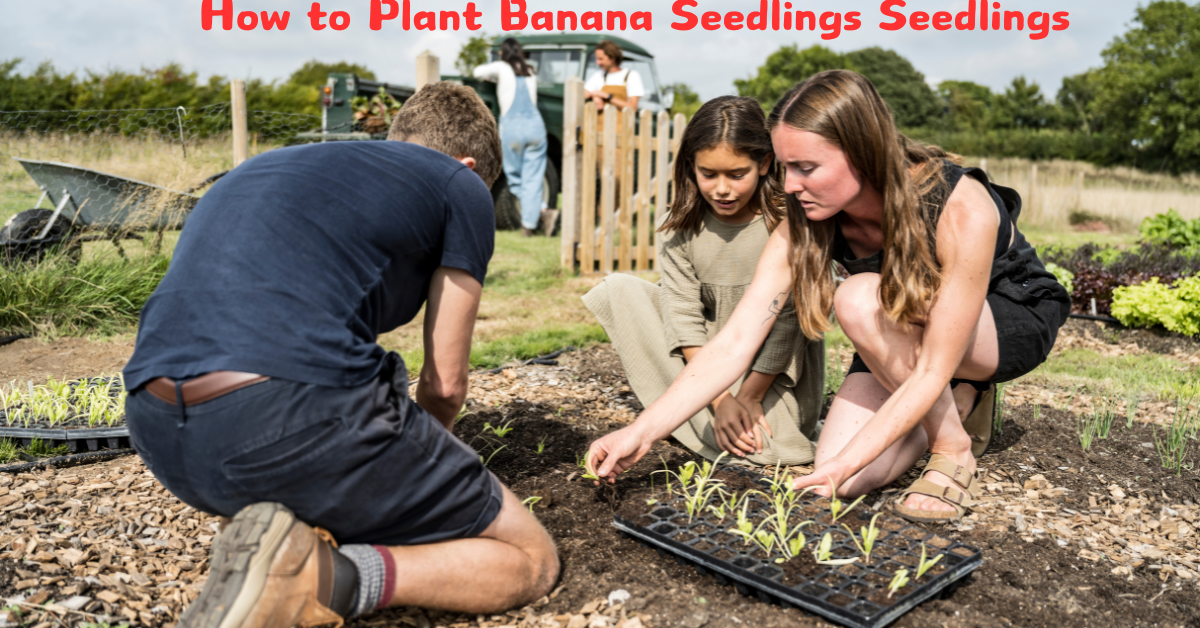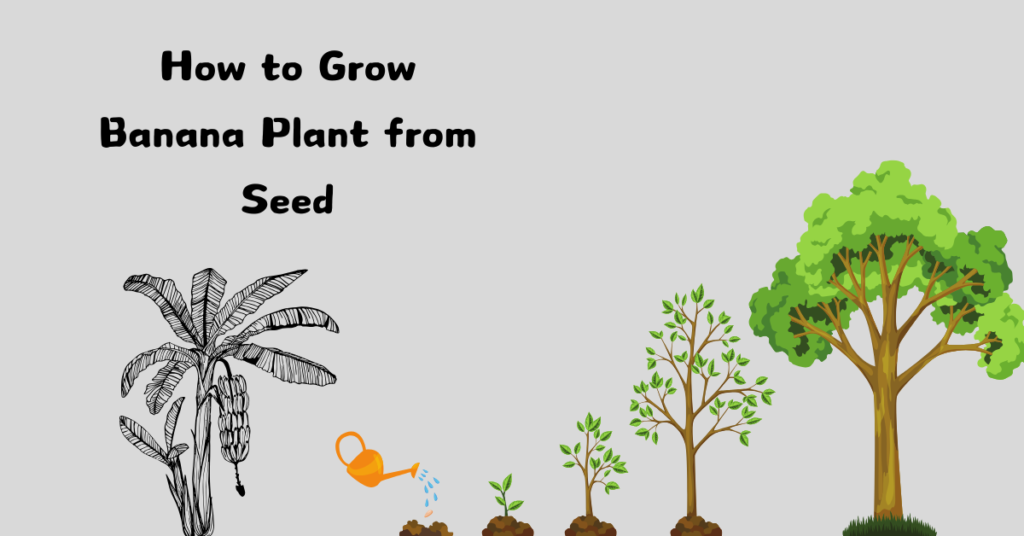Growing banana plants from seed is a curious and fulfilling planting venture. Whereas numerous people are recognizable with growing bananas from suckers or branches, beginning from seed offers an interesting and challenging encounter.
This article will take you through the step-by-step preparation of developing a banana plant from seed, covering everything from seed choice to care and upkeep.
Do Bananas Have Seeds?
Yes, bananas do have seeds, but they are very little and not ordinarily recognizable in the bananas we eat. Most of the bananas expended around the world are of the Cavendish assortment, which is developed to be seedless for comfort and agreeability.
These bananas have little, minimal seeds interior that are basically remainders of what would have been bigger seeds in wild banana varieties.
In differentiate, wild bananas have bigger seeds and are not as sweet or as simple to eat. The developed bananas are proliferated through cloning, so they don’t depend on seeds for propagation.
Can You Grow Bananas from Seeds?
you can grow bananas from seeds, but it’s very rare and challenging. Most bananas that we eat today are proliferated through cloning strategies, like utilizing suckers or tissue culture, since the bananas commonly devoured (like the Cavendish assortment) are seedless and don’t create practical seeds.
If you’re interested in growing bananas from seeds, here’s a common diagram of the process:
- Obtain Seeds: See for seeds from a banana assortment that produces them. These are as a rule wild or legacy assortments, not the common developed types.
- Prepare the Seeds: Banana seeds require to be cleaned and now and then doused to help with germination. This might include evacuating any fruit mash and splashing the seeds in water for a day or two.
- Planting: Plant the seeds in a well-draining preparing blend, around 1 inch profound. Keep the soil wet but not waterlogged.
- Germination Conditions: Banana seeds require warmth to sprout. Keep the soil temperature between 70-85°F (21-29°C). It might take a few weeks to months for seeds to germinate.
- Care: Once seedlings rise, they require bounty of light and warmth. Proceed to keep the soil wet and give great drainage.
- Transplanting: When seedlings are expansive sufficient and have created a solid root system, you can transplant them into bigger pots or specifically into the ground, if the climate permits.
How to Plant Banana Seedlings
Planting banana seedlings is a fulfilling endeavor, and whereas bananas are ordinarily developed from suckers or maybe than seeds, here’s a direct to offer assistance you if you’re working with seedlings or proliferating from seeds:
If You’re Planting Banana Seedlings:
Choose the Right Location
Bananas require full sun for ideal development. Guarantee the spot you select gets at slightest 6-8 hours of daylight per day.
The soil ought to be well-draining. Bananas don’t like waterlogged conditions, so maintain a strategic distance from ranges where water tends to pool.
Prepare the Soil
Enrich the soil with natural matter such as compost or well-rotted excrement. This makes strides soil richness and drainage.
Aim for a marginally acidic to unbiased soil pH (5.5 to 7.0).
Dig a Planting Hole
Dig a gap that is twice as wide and the same profundity as the root ball of the seedling. This will provide the roots bounty of room to spread out.
If planting different seedlings, space them approximately 8-10 feet separated to permit for their growth.
Plant the Seedling
Place the seedling in the gap so that the beat of the root ball is level with the encompassing soil.
Fill the gap with soil, tenderly tamping it down to expel discuss pockets.
Water the plant altogether after planting to offer assistance settle the soil around the roots.
Mulch and Water
Apply a layer of mulch around the base of the plant to offer assistance hold dampness and smother weeds.
Keep the soil reliably damp but not waterlogged. Bananas are parched plants and require standard watering.
Fertilize
Feed your banana plants with a adjusted fertilizer, or one tall in potassium, which is vital for natural product development.
Follow the informational on the fertilizer bundle for application rates and timing.
Care and Maintenance
Regularly check for bugs and infections. Common issues incorporate aphids and contagious infections.
As the plants develop, expel any dead or harmed clears out to keep the plant healthy.
Support the banana plants if required, particularly in blustery zones, to avoid them from toppling over.
If You’re Beginning from Banana Seeds:
Seed Preparation
Banana seeds are little and can be moderate to grow. Dousing them in water for 24 hours some time recently planting can offer assistance make strides germination rates.
Seed Sowing
Fill seed plate or pots with a seed-starting blend or a mix of peat and perlite.
Sow the seeds on the surface of the soil and gently cover them with a lean layer of soil or vermiculite.
Germination Conditions
Keep the soil reliably damp but not soggy.
Place the plate or pots in a warm, sunny area or beneath develop lights. Keep up a temperature of around 70-80°F (21-27°C) for ideal germination.
Transplanting Seedlings
Once the seedlings have created a few sets of genuine clears out and are expansive sufficient to handle, they can be transplanted to their lasting open air location.
Planting banana seedlings can be a fun and beneficial cultivating extend. With the right care and consideration, you’ll have a flourishing banana plant that can in the long run create natural product!

How Bananas Produce
Bananas are interesting plants with a special way of replicating. Here’s a fundamental diagram of how they produce:
- Vegetative Propagation: Most bananas are proliferated asexually. They develop from a base structure called a “corm,” which is an underground capacity organ. This corm produces shoots called “suckers” or “pups” that rise from the base of the plant. These suckers develop into modern banana plants, which are hereditarily indistinguishable to the parent.
- Flowering and Fruiting: In terms of sexual generation, banana plants do bloom and create natural product. The blossoming handle starts when the plant comes to development. The banana plant creates a expansive inflorescence (a cluster of blossoms) that develops from the best of the plant. This inflorescence is encased in a expansive purple leaf-like bract.
- Pollination: Bananas are regularly self-pollinating, but they can too be pollinated by creepy crawlies or, in a few cases, wind. The blooms are little and are orchestrated in columns inside the inflorescence. The plant produces both male and female blossoms, but as it were the female blooms create into bananas.
- Fruit Advancement: Once pollinated, the female blooms create into bananas. These bananas develop in clusters called hands, and each hand comprises of different bananas, or “fingers.” The fruit develops upwards, and the banana plant’s unmistakable bended shape creates as the bananas grow.
- Harvesting: Bananas are ordinarily collected whereas they are still green and permitted to mature off the plant. This is since bananas proceed to age after they are picked, and gathering them early makes a difference anticipate them from getting to be overripe amid transport.
So how do we start these gigantic herbs from seed?
- Select Your Seeds: Make beyond any doubt you have high-quality seeds of the tremendous herb you need to develop. Well known illustrations might be mammoth basil assortments or expansive dill types.
- Prepare Your Soil: Utilize a well-draining seed-starting blend. You can make a blend with peat greenery, perlite, and vermiculite, which makes a difference hold dampness whereas permitting overabundance water to drain.
- Sow the Seeds: Take after the particular planting profundity enlightening on the seed parcel. For numerous huge herbs, you’ll plant the seeds almost 1/4 inch to 1/2 inch profound. You might need to begin with a seed plate or little pots.
- Watering: Keep the soil reliably wet but not waterlogged. You can utilize a fine fog shower bottle to dodge aggravating the seeds.
- Provide Warmth: Most seeds grow best in warm temperatures. Check the seed parcel for ideal temperature ranges, but by and large, a temperature between 65-75°F (18-24°C) works well.
- Light: Once seeds grow, they will require a part of light to develop solid. If you’re beginning them inside, consider utilizing develop lights or setting them in a sunny window.
- Transplanting: When the seedlings have a few sets of genuine takes off and are huge sufficient to handle, you can transplant them to bigger pots or straightforwardly into the plant. Make beyond any doubt the chance of ice has passed and the soil is warm enough.
- Care: Once transplanted, proceed to care for your herbs by watering frequently, guaranteeing they have satisfactory light, and giving supplements as required. For tremendous herbs, you might require to back their development with staking or cages.
Propagating Banana Plants
Proliferating banana plants can be a fulfilling and generally clear handle. Here’s a direct to offer assistance you through it:
1. Understanding Banana Plant Structure
Banana plants are regularly developed from underground rhizomes or suckers. These are the primary strategies of propagation:
Rhizome Propagation
- Rhizome: This is a even underground stem from which modern shoots grow.
Sucker: This is a shoot that rises from the base of the plant or from the rhizome.
2. Proliferation Methods
1. Suckers
- Choose the Right Sucker: See for suckers (too called pups) that are sound, at slightest 1/3 the measure of the fundamental plant, and have roots. They ought to in a perfect world be from the base of the plant.
- Separate the Sucker: Utilize a sharp, clean cut or spade to carefully partitioned the sucker from the primary plant, making beyond any doubt to incorporate a few roots if possible.
- Prepare the Modern Planting Location: Plant the sucker in a well-drained soil enhanced with compost. Space them almost 4-6 feet separated to provide them room to grow.
- Watering: Keep the soil reliably damp but not waterlogged. The plant ought to start to build up itself inside a few weeks.
2. Rhizomes
- Harvest Rhizomes: Burrow up a parcel of the rhizome from an set up plant. The rhizome ought to have a few roots and a few hubs (budding points).
- Prepare the Rhizome: Cut the rhizome into areas, each with at slightest one hub. Let the cut surfaces dry out for a day or two to decrease the chance of rot.
- Plant the Rhizome: Plant the rhizome pieces approximately 6-12 inches profound in a well-drained soil blend. Guarantee that the hub is confronting upward.
- Watering: Keep the soil reliably damp. It may take a few weeks for modern shoots to appear.
-
3. Care After Planting
- Light: Banana plants flourish in full sun but can endure halfway shade.
- Fertilization: Nourish the plants with a adjusted fertilizer or one tall in potassium. Fertilize each 6-8 weeks amid the developing season.
- Pest and Infection Administration: Observe out for bothers like aphids and maladies like Panama illness. Appropriate care and great cleanliness can offer assistance avoid these issues.
4. Tips for Success
- Climate: Banana plants lean toward warm, tropical climates. Guarantee that your developing range has temperatures between 75-95°F (24-35°C) and satisfactory humidity.
- Mulching: Apply mulch around the base of the plant to hold dampness and control soil temperature.
- Support: As the plants develop, they may require staking to anticipate them from toppling over, particularly if they are developed in blustery regions.
Growing Banana Plants from Seed: A Step-by-Step Guide
Step |
Description |
|---|---|
| 1. Obtain Seeds | Get fresh banana seeds from a reputable source. Note that many bananas sold commercially are hybrids and may not produce viable seeds. |
| 2. Soak Seeds | Soak the seeds in warm water for 24-48 hours. This helps to soften the seed coat and promote germination. |
| 3. Prepare Soil | Use a well-draining, nutrient-rich potting mix. A blend of peat moss, vermiculite, and perlite works well. |
| 4. Plant Seeds | Plant the seeds about 1/2 inch deep in the soil. Space them a few inches apart if planting multiple seeds. |
| 5. Create a Warm Environment | Cover the pots with plastic wrap or place them in a greenhouse to maintain high humidity and warmth. Bananas prefer temperatures between 75-85°F (24-29°C). |
| 6. Watering | Keep the soil consistently moist but not waterlogged. Mist the surface regularly to maintain humidity. |
| 7. Germination | Germination can take several weeks to a few months. Be patient and continue to provide warmth and moisture. |
| 8. Transplanting | Once seedlings have developed several leaves and are large enough to handle, transplant them into larger pots or directly into the ground. |
| 9. Care | Banana plants need plenty of sunlight, regular watering, and occasional feeding with a balanced fertilizer. Ensure good drainage to prevent root rot. |
| 10. Maintenance | Continue to care for the plant by monitoring for pests and diseases, and providing adequate support as it grows. |
FAQs – How to Grow Banana Plant from Seed
How long does it take for banana seeds to germinate?
Banana seeds ordinarily take between 2 to 12 weeks to sprout. The correct time can change based on seed assortment, temperature, and other developing conditions.
Can you grow a banana plant indoors?
Yes, you can develop a banana plant inside, given you can offer the right conditions such as warm temperatures, tall stickiness, and shinning light. Predominate assortments are especially appropriate for indoor cultivation.
How often should I water my banana plants?
Banana plants lean toward reliably damp soil. Water the plants routinely to keep the soil clammy but not wet. Alter the recurrence based on the plant’s estimate and natural conditions.
What type of fertilizer is best for banana plants?
Use a adjusted, water-soluble fertilizer for banana plants. A definition with rise to parts nitrogen, phosphorus, and potassium (e.g., 10-10-10) works well. Apply agreeing to the manufacturer’s instructions.
Can I grow bananas from store-bought bananas?
Store-bought bananas are ordinarily developed from clones or maybe than seeds, so they are not reasonable for planting. For developing bananas from seed, you’ll require to source seeds particularly aiming for planting.
How long does it take to grow bananas from seed?
- Germination: Banana seeds can take anywhere from 2 to 6 weeks to germinate, depending on temperature and moisture conditions.
- Seedling Stage: After germination, it takes several months (usually around 6 to 8 months) for the seedlings to grow large enough to be transplanted.
- Mature Plant: Once transplanted, it can take an additional 9 to 12 months for the plant to grow enough and develop fruit.
Conclusion
Learning how to develop a banana plant from seed can be a satisfying and instructive involvement. Whereas it requires tolerance and cautious consideration, the rewards of sustaining a banana plant from its most punctual stages are well worth the exertion.
From selecting and planning the seeds to giving the right developing conditions and managing with common issues, this direct covers everything you require to effectively develop your possess banana plant.
Whether you’re interested in the consumable natural product or fair the excellence of the plant, developing bananas from seed is a special cultivating enterprise that can bring delight and fulfillment. Cheerful planting!



